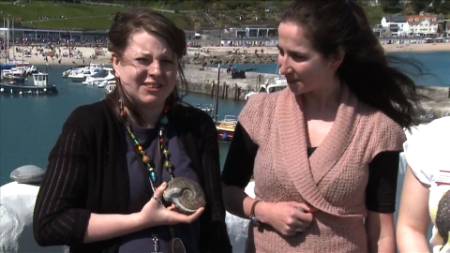With our satellite dish at the ready, the sun shining and half a dozen Museum scientists raring to go, last weekend's Nature Live events went down a storm!
Linking back to the studio from the harbour in Lyme Regis, we brought the annual Fossil Festival to South Kensington. For visitors who were unable to visit the south coast in person, we revealed why Lyme Regis is THE place to go fossil hunting and showed our audiences some of the weird and wonderful specimens that can be found there.
Museum curator Zoe Hughes reveals an Ammonite, found in the local area.
Does this count as Big Pond dipping?
Sunday's events brought us up to date with the organisms that call our seashore home. I was out first thing trying my luck with my bucket and net. I think I was the oldest 'rock-pooler' on the beach! Unfortunately, I didn't manage to find very much, except for lots of seaweed ... but this proved to be far more interesting than I had first thought!
Museum scientist Lucy Robinson explained that there are many different species of seaweed to be found along our coastline, varying in colour, shape and size. She also explained the various ways seaweeds and their extracts can be used - in toothpaste, ice-cream, fertilizer and cosmetics (to name but a few).
And of course, some types of seaweed can be eaten - such as sea lettuce. Lucy and I decided to give it a go ... our conclusion, it's very salty and a bit crunchy (but I think that may have been sand!) To find out more about seaweed and how to identify them, visit our Big Seaweed Search pages.
Yum!
Lyme Regis is a great place to visit at any time of the year. If you're interested in fossil hunting, look out for the many guided walks that are on offer throughout the year, giving you the opportunity to explore the beaches with a local palaeontologist who knows what to look out for and who can tell you more about the fossils that are found there.
And if you'd like to experience the Fossil Festival for yourselves, put this date in your diaries: Saturday 3 and Sunday 4 May 2014. If this year is anything to go by, it will be another great weekend!




